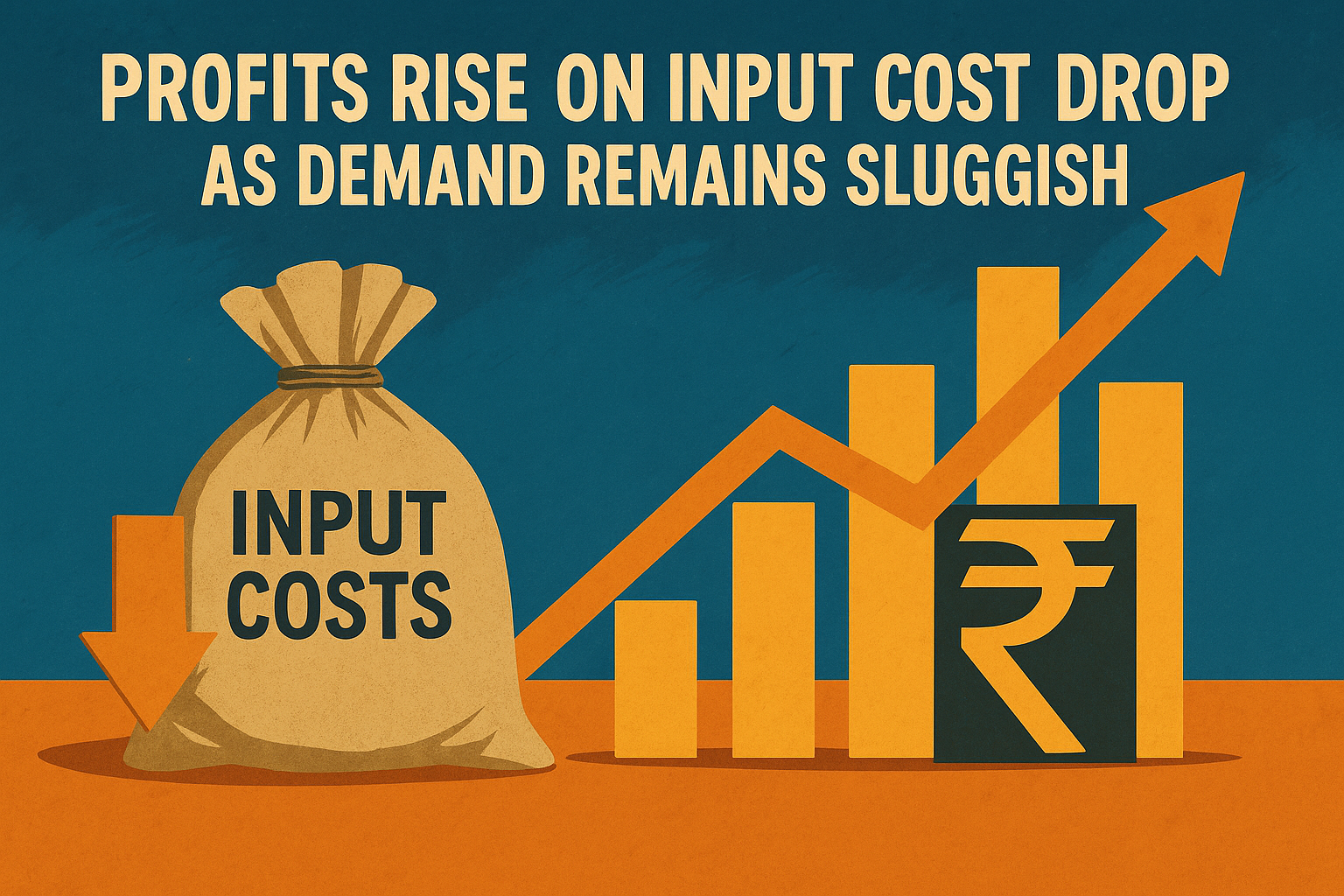As Indian companies grappled with sluggish demand in the June quarter, an unexpected financial windfall emerged—not from rising sales, but from plunging input costs. While revenue growth limped forward, profits surged at their fastest pace in five quarters, providing a much-needed breather to corporate India.
Revenue Growth Stalls, But Profits Soar
An analysis of 182 companies’ standalone Q1 FY26 results shows a modest 5.4% year-on-year (YoY) increase in total income, but a striking 23% jump in net profits. This profit spike can be attributed primarily to a 14% YoY decline in raw material costs, the steepest drop in two years. Compared to the previous quarter (Q4 FY25), input costs were also 15% lower, the sharpest sequential fall since Q1 FY22.
This decline in production expenses is a clear signal that Indian producers are benefitting from global input cost deflation—particularly in crude oil, metals, and chemicals. Wholesale price inflation during April-June stood at just 0.4%, down sharply from 2.4% in the preceding quarter.
Topline Weakness vs. Bottomline Strength
For non-financial companies, this input cost advantage has been transformative. In Q1 FY26:
- Topline growth dropped to a seven-quarter low of 0.85%
- Net profit, in contrast, rose a staggering 40%, the highest in 12 quarters
- Profit margins surged to 13.8%, a level unseen since Q4 FY21
This divergence underlines the role of raw material costs in shaping profitability, particularly in a demand-constrained environment.
Cushioning Rising Employee Expenses
Lower input costs also allowed companies to comfortably absorb higher wage bills. Employee costs as a share of net sales jumped to nearly 18%, the highest in 17 quarters. This spike, typical for Q1 due to annual appraisals, was nonetheless better absorbed thanks to falling raw material expenses, which hit a multi-quarter low of 40.6% of net sales.
Analysts believe this trend may signal early signs of wage-driven income growth, potentially supporting urban demand in subsequent quarters.
Muted Demand Clouds Outlook
Despite these profit gains, the underlying issue of weak consumer demand remains unresolved. Experts are cautiously optimistic that recent policy measures—such as income tax breaks, interest rate reductions, and liquidity support—could begin to stimulate demand by Q3 FY26.
However, most analysts, including those at Centrum Broking and Ionic Wealth, expect another 2–3% downward revision in FY26 earnings estimates, even with Q1’s profitability surprise. Nifty 50 earnings growth is now forecast at around 10% YoY for the year.
Will Input Cost Tailwinds Last?
The decline in raw material prices is unlikely to last indefinitely. Harsh Gupta Madhusudan of Ionic Wealth cautions that a dollar downcycle may push commodity prices up from 2026 onwards. Yet, he adds, Indian companies have not fully leveraged their operational and financial capacity, leaving room for margin expansion even without input cost support.
Moreover, while corporate profit-to-GDP ratio has hit a 17-year high of 4.7%, demand revival remains the critical piece of the puzzle for sustained profitability and expansion.
Sectors to Watch: Mid-Caps and Cement Lead the Pack
Market sentiment currently favors mid-cap stocks, continuing the trend from FY25. The cement sector is also projected to outperform in Q1, while large-cap indices like the Nifty 50 may bounce back as earnings in banking, IT, and auto sectors bottom out by Q2 FY26.
Potential upside triggers include:
- A US-India trade deal
- A possible interest rate cut by the RBI in August
- Improved consumer spending capacity aided by rising wages
Conclusion: Profits Find Relief, But Demand Still Elusive
Q1 FY26 painted a rare picture: profits booming while revenues stagnated. The collapse in input costs helped India Inc. buy time, but not customers. Whether these gains can be sustained depends heavily on demand revival in the coming quarters. For now, Indian companies have weathered the storm—but the true test lies ahead.
Feel free to share your experiences and insights in the comments below. Let’s continue the conversation and grow together as a community of traders and analysts.
By sharing this experience and insights, I hope to contribute to the collective knowledge of our professional community, encouraging a culture of strategic thinking and informed decision-making.
As always, thorough research and risk management are crucial. The dynamic nature of financial markets demands vigilance, agility, and a deep understanding of the tools at your disposal. Here’s to profitable trading and navigating the election season with confidence!
Ready to stay ahead of market trends and make informed investment decisions? Follow our page for more insights and updates on the latest in the financial world!
For a free online stock market training by Yogeshwar Vashishtha (M.Tech IIT) this Saturday from 11 am – 1 pm, please sign up with https://pathfinderstrainings.in/training/freetrainings.aspx
Experience profits with my winning algo strategies – get a free one-month trial with ₹15 lakh capital! – https://terminal.algofinders.com/algo-terminal
Disclaimer
This article should not be interpreted as investment advice. For any investment decisions, consult a reputable financial advisor. The author and publisher are not responsible for any losses incurred by investors or traders based on the information provided.


